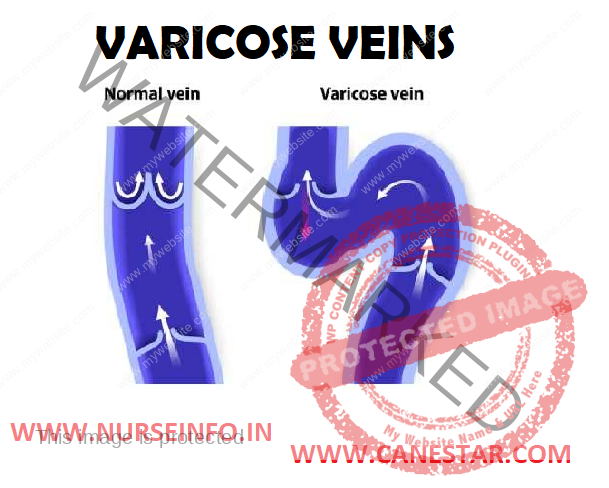VARICOSE VEINS – Types, Stages, Etiology, Risk Factors, Clinical Manifestations, Diagnostic Evaluations and Management
Veins are blood vessels that return deoxygenated blood from the outer parts of the body back to the heart and lungs. When veins become abnormally thick, full of twists and turns, or enlarged, they are called varicose veins. This happens most commonly in the veins in the legs and thighs
TYPES
- The superficial veins and their branches are close to the skin. Also included in this category are the communicator or perforator veins, which connect the superficial veins with the deep veins
- The deep veins are encased by muscle and connective tissue, which help to pump the blood in the veins and back to the heart. The veins have one-way valves to prevent them from developing varicosities.
STAGES
- C0 – no visible or palpable signs of venous disease
- C1 – telangiectasia or reticular veins
- C2 – varicose veins
- C3 – edema
- C4a – skin changes due to venous disorders: pigmentation, eczema
- C4b – as C4 but with healed ulcers
- C6 – skin changes with active ulcers (venous insufficiency ulceration)
ETIOLOGY
- Heredity
- Pregnancy
- Obesity
- Menopause
- Aging
- Prolonged standing
- Leg injury
- Abdominal straining
- Crossing legs at the knees or ankles
RISK FACTORS
- Pregnancy is associated with an increase in blood volume
- Prolonged standing
- Obesity or distended belly
- Straining: chronic constipation, urinary retention from an enlarged prostate, chronic cough
- Prior surgery or trauma to the leg. These conditions interrupt the normal blood flow channels
- Age: generally, most elderly individuals show some degree of varicose vein occurrence
CLINICAL MANIFESTATIONS
- Aching, heavy legs
- Appearance of spider in the affected leg
- Ankle swelling, especially in evening
- A brownish-blue shiny skin discoloration near the affected veins
- Redness, dryness and itchiness of areas of skin
- Cramps may develop especially when making a sudden move as standing up
- Minor injuries to the area may bleed more than normal and/or take a long time to heal
- Restless legs syndrome appears to be a common overlapping clinical syndrome in patients with varicose veins and other chronic venous insufficiency
- Whitened, irregular scar-like patches can appear at the ankles. This is known as atrophie blanche.
DIAGNOSTIC EVALUATION
- Duplex Doppler Ultrasound scanning: all patients with varicose veins should now be investigated using ultrasound
- CT scanning
MANAGEMENT
Conservative Management
- Elevating the legs often provides temporary symptomatic relief
- Advice about regular exercise sounds sensible but is not supported by an evidence
- The wearing of graduated compression stockings with variable pressure to correct the swelling, nutritional exchange, and improve the microcirculation in legs affected by varicose veins
- The wearing of intermittent pneumatic compression devices have been shown to reduce swelling and increase circulation
- Diosmin/hesperidine and other flavonoids
- Anti-inflammatory medication, such as ibuprofen or aspirin can be used as part of treatment for superficial thrombophlebitis
SURGICAL MANAGEMENT
Stripping
Stripping consists of removal of all or part of the saphenous vein (great/long and/or lesser/short) main trunk. The complications include deep vein thrombosis, pulmonary embolism, and wound complications including infection
Nonsurgical Management
Sclerotherapy
A commonly performed nonsurgical treatment for varicose and ‘spider’ leg veins is sclerotherapy in which medicine is injected into the veins to make them shrink. The medicines that are commonly used for sclerosants are polidocanol (POL), sodium tetradecyl sulfate.
COMPLICATIONS
- Pain, heaviness, inability to walk or stand for long hours, thus hiddering work
- Dermatitis which could predispose skin loss
- Skin ulcers especially near the ankle, usually referred to as venous ulcers
- Development of carcinoma or sarcoma in longstanding venous ulcers. Severe bleeding from minor trauma, of particularly concern in the elderly
- Blood clotting within the affected veins
- Acute fat necrosis can occur especially at the ankle of overweight patients with varicose veins. Females are more frequently affected than males
- The affected person suffers tenderness in that region

VARICOSE VEINS – Types, Stages, Etiology, Risk Factors, Clinical Manifestations, Diagnostic Evaluations and Management

